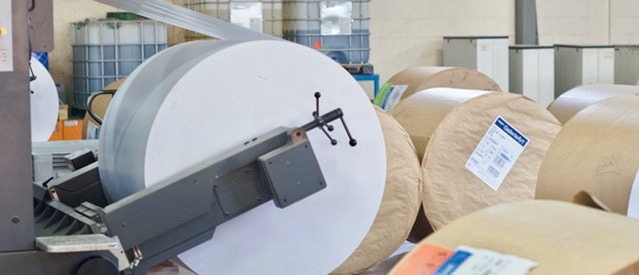Lightning Source Indie Days : Miles of paper, millions of books flow from Ingram’s Tennessee factory

La VERGNE, TENN—During a tour of the vast Lightning Source factory during Indie Days , publishers learned that this worldwide network of printing plants produces 60,000 books a day and 1 million books a week!
Like other major manufacturers—especially the auto industry—book production has been moving toward a just-in-time supply system. Originally called Print on Demand (POD), when it was an emerging part of the industry more than a decade ago, just-in-time production now has been adopted by thousands of publishers. Even the Big 5, which used to order big press runs and warehouse the stock, now switches many of its backlist titles over to just-in-time printing.
That is why Lightning Source’s average order of units is an astonishing 2 books. Within moments, 2 copies of a book can fly off these big printers, followed perhaps by 1 copy of another book, then 6 of a different title—varying what is being printed every few minutes, all day long.
About 30,000 different books are printed every day in Lightning Source factories around the world. The Lightning Source catalog now lists 17 million different book titles that can be produced in these plants. Amazon currently lists about 33 million books for sale, a total that includes millions of eBooks, so that means Lightning Source’s machines are set up to produce a lion’s share of the books sold each day.
It was very impressive to see the 55-gallon barrels that hold the ink that the HP printers use—the same four colors that our home printers use, just a whole lot bigger.
The rolls of paper that are fed into the printers contain 7 miles of paper on each roll and it only takes 75 minutes for the 500-feet-per-minute printers to consume an entire 7-mile roll of paper.
All of the paper rolls in these factories come from sustainable paper farms and, when you see how much of it is being used, you are grateful for that conscientiousness by Lightning Source’s buyers.
Our tour group was taken into the quality-control laboratory. The lab is where each shipment of paper is tested for compliance with Lightning Source standards. Once books are printed and ready for shipment, a random selection is made to check for quality and to test the books for durability.
Indie Days was a great opportunity for publishing house teams to see the printing facility first hand. It’s amazing to see the quantity and quality of books that are printed 24/7 at this plant. Every person I met had an obvious pride in what they were doing and rightfully so.
With the addition of the latest, industrial-size HP printers, errors have been reduced significantly. The process, while mostly automated, still requires some human intervention, especially when producing a hardcover book and packing the books for shipment.